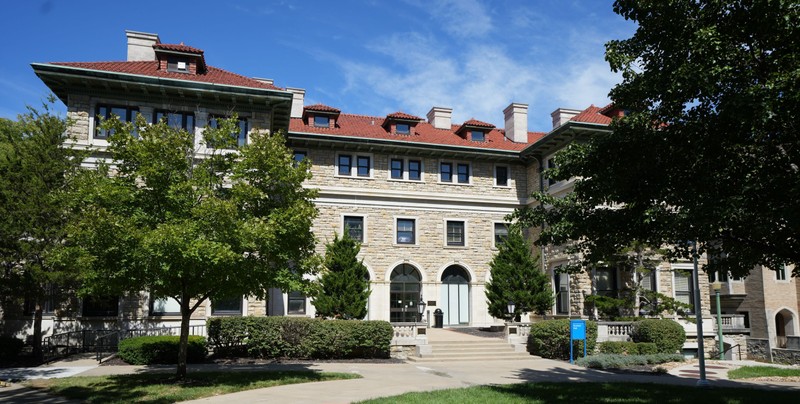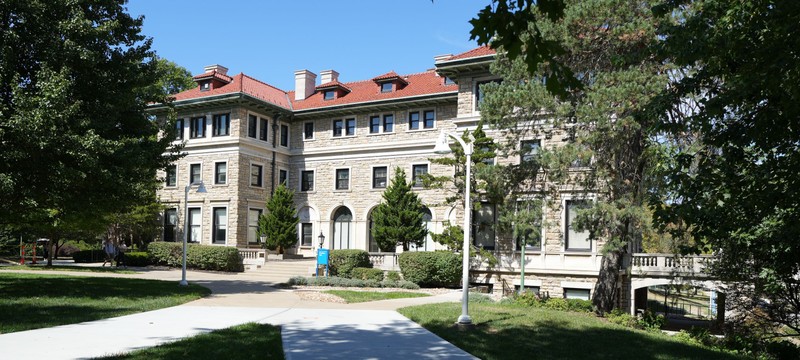Scofield Hall
Introduction
Text-to-speech Audio
Constructed from 1912 to 1914 for industrialist and local newspaper publisher Walter S. Dickey, this stately mansion became the first building of the University of Kansas City after philanthropist William Volker acquired the property and donated it to the new university in 1930. Volker was one of the strongest advocates for the new university, and with his help, classes started in the fall of 1933 despite the financial turmoil wrought by the Great Depression. The building was later renamed in honor of former chancellor Clarence Scofield who oversaw the transition from a private university to a member of the University of Missouri system. Dr. Scofield became the last president of the University of Kansas City in 1961, and following the successful merger, he retired as chancellor of the University of Missouri-Kansas City in 1965.
Images
Kansas City philanthropist William Volker purchased this mansion and the surrounding acreage to support efforts by city boosters to build a university at this location.

The building was later renamed to recognize the contributions of Clarence Scofield who led the transition from private to public university

Backstory and Context
Text-to-speech Audio
Walter S. Dickey migrated to Kansas City from Canada in 1885. A few years later, he started the W.S. Dickey Clay Manufacturing Company, which made ceramic pipes out of burnt clay. First, the business sold these pipes to farmers to drain their land with. However, as technology grew and developed, W.S. Dickey began selling to phone companies as early phone lines were put down. In addition, as more municipalities in the area developed their own sewage systems, the company began to sell to them, too, finding great success in doing so. In 1912, after his clay company proved successful, Dickey began construction on the Dickey Mansion at 51st and Rockhill Roads in Kansas City, Missouri. It took two years to complete.
After other business ventures failed and his investments crashed, putting him millions of dollars in debt, Dickey died in 1931. Kansas City philanthropist William Volker purchased Dickey's mansion and promptly gave it as a gift to the future University of Kansas City. It was the university's first building when the school opened its doors in 1933. Voller also personally donated funds to support many of 260 students who constituted the first class at the new university.
The former Dickey Mansion, now called Scofield Hall, was the only building until 1935 when the Science Building was completed thanks again to a donation from Volker. The ground floor of the former mansion was converted to hold offices and the school library. The second floor, which used to contain bedrooms, was converted into classroom space. The third-floor kitchen became a laboratory with supplies paid for in part by a $10,000 donation from nearby Menorah Hospital, which had opened its doors just a few years earlier.
The building was later renamed to recognize the contributions of Clarence Scofield who was thrust into the presidency in 1961 following the abrupt resignations of Earl McGrath in 1956 and Richard Drake in 1961. Both of his predecessors had sought private donations to bridge the gap between tuition receipts and the university's expenses. After two years of trying the same approach with similar results, Scofield was convinced that the only path to financial stability was accepting a merger with the University of Missouri.
Although the student body of the University of Kansas City was growing each year, tuition only covered sixty percent of operational costs. In addition, both the University of Missouri and the University of Central Missouri were working to create satellite campuses in Kansas City, and these state-subsidized schools offered lower tuition. Although he shared their desire to remain independent, Scofield worked to convince other university leaders that accepting a merger was the best path to preventing the eventual closure of the school.
After a series of meetings that began in January of 1963, university leaders announced the merger on February 26, 1963. In the following months, the state legislature approved funds to support the incorporation and expansion of Kansas City's campus into the University of Missouri's system which included the conversion of Normandy County Junior College to the University of Missouri at St. Louis. Scofield led the transition of UKC to UMKC until the summer of 1965 when he reached the state's mandatory retirement age of 65.
Carleton Forman Scofield earned a Ph.D. in psychology from Yale in 1928 and taught for many years at the University of Buffalo, Scofield left academia briefly during World War II and worked for the U.S. Office of Strategic Services, the predecessor to the Central Intelligence Agency, to support of their efforts in the war in the Pacific. For the next fifteen years, Scofield alternated between teaching and federal service, researching topics like psychological warfare while interviewing refugees from the Soviet Union and accepting federal assignments throughout the Middle East and Southeast Asia. After his retirement from UMKC, Scofield worked to support public educational television in Kansas City.
Sources
Scofield, Carleton. A History of the University of Kansas City: Prologue to a Public Urban University. Kansas City, MO. Lowell Press, 1976.
Wolff, Christopher. A Pearl of Great Value: The History of UMKC, Kansas City’s University. Kansas City, Missouri. UMKC Alumni Association, 2016.
Crawford, Tonya. "A Foundation Made of Stone," Old School: The UMKC University Archives Blog. September 15th, 2015. Accessed July 27th, 2022. https://kcroonews.com/scofield-hall-is-a-former-mansion/.
"UMKC's first chancellor, Carleton F. Scofield, dies." (Kansas City Star) March 15th, 1990.
Photo by David Trowbridge
Photo by David Trowbridge
